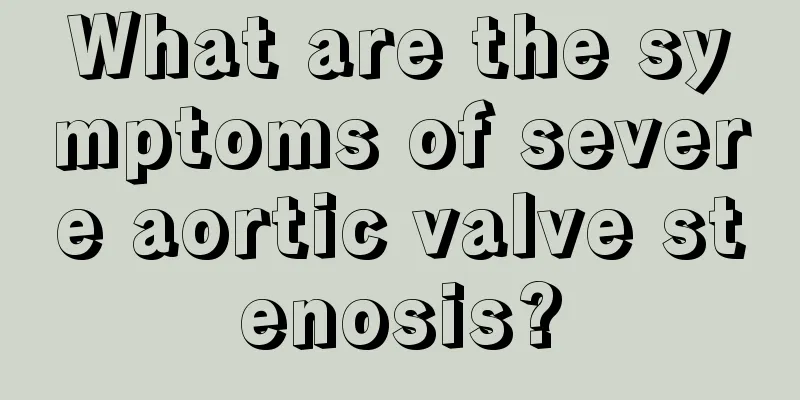What are the symptoms of severe aortic valve stenosis?

|
Aortic stenosis refers to a condition in which the aortic valve cannot open completely during systole due to congenital or acquired factors. When aortic valve stenosis is mild, there are no special symptoms. But over time, when the aortic valve becomes severely narrowed, it may lead to congestive heart failure, and the patient will feel easily fatigued, short of breath, swollen ankles, etc. So, what are the symptoms of severe aortic valve stenosis? What are the symptoms of severe aortic valve stenosis? ① Angina pectoris: Angina pectoris caused by aortic valve stenosis often indicates that the valve area is less than 0.8cm2, which is difficult to distinguish from angina pectoris caused by coronary heart disease. The cause of angina pectoris caused by aortic valve stenosis may be the increased oxygen demand caused by myocardial hypertrophy and the insufficient oxygen supply caused by the relative decrease in coronary flow, which in turn causes subendocardial myocardial ischemia. According to statistics, regardless of whether they have angina pectoris or not, about 50% of patients with aortic valve stenosis over the age of 40 have coronary heart disease. ② Syncope: Blackening of the eyes or temporary loss of consciousness often occurs after work or when suddenly changing from a supine to an upright position. Its occurrence may be the same as angina pectoris mechanism, that is, when myocardial oxygen demand increases, myocardial oxygen supply decreases. Exertional syncope is caused by peripheral vasodilation due to exertion without a corresponding increase in cardiac output. Orthostatic syncope is caused by the inability to increase cardiac output when standing suddenly. Sometimes syncope may occur when taking sublingual nitroglycerin to treat angina pectoris. That is, a small dose of nitrates can cause a significant dilation of peripheral veins, resulting in a decrease in the amount of blood returning to the heart and a decrease in the preload of the heart. When the dose is increased, the peripheral resistance arterioles also dilate, causing the left ventricular afterload to decrease, but there is no corresponding increase in cardiac output, resulting in insufficient blood supply to the cerebral circulation. In addition, severe arrhythmias caused by myocardial ischemia, such as sustained ventricular tachycardia, high-degree atrioventricular block, severe sinus bradycardia, etc., can also lead to syncope or sudden death. Patients with syncope or angina pectoris survive an average of 2 to 5 years. ③ Left heart failure: From early exertional dyspnea, it progresses to paroxysmal nocturnal dyspnea, orthopnea and acute pulmonary edema. Early stage heart failure may be related to left ventricular diastolic dysfunction; late stage heart failure may be related to left ventricular systolic dysfunction. The life expectancy of patients with aortic stenosis and left heart failure is expected to be no more than 2 years. ④Sudden cardiac death: It may be the first symptom of aortic valve stenosis, or there may be a history of repeated angina pectoris or syncope. The cause of sudden death is mostly related to ventricular fibrillation or cardiac arrest induced by acute myocardial ischemia. What are the symptoms of severe aortic valve stenosis? As can be seen from the above, severe aortic valve stenosis is a critical disease. If not treated in time, it will lead to multiple complications such as acute pulmonary edema, thromboembolism, heart failure, etc. Therefore, when treating severe aortic valve stenosis, patients must be very vigilant, detect and prevent it early, and eat less high-fat and high-salt foods in daily life. |
<<: What are the symptoms of severe aortic valve stenosis?
>>: What are the dangers of smoking
Recommend
What are the symptoms of prostate cancer? What causes prostate cancer?
There are many male friends around us who are tro...
Can omeprazole treat gastritis?
In current clinical practice, omeprazole is mainl...
Can you still have sex after prostate cancer surgery? Sexual rehabilitation program fully disclosed
1. 97% survival rate does not mean no need to be ...
What are the disadvantages of not getting sun exposure
With the quickening pace of modern life, more and...
There is a part of the body that is more unhealthy the darker it is
All parts of the human body are closely related. ...
The most important treatment for kidney cancer
Kidney cancer is a common disease in life. There ...
What does the saliva method for testing Helicobacter pylori mean
What is Helicobacter pylori? I believe that apart...
Will stomach cancer recur? It is possible to recur
Gastric cancer is likely to recur, and the recurr...
How to prevent teratoma in winter
In fact, when the human embryo is developing, the...
What are the effects of alum and vinegar together
Alum is a food additive. For example, alum is add...
Early symptoms of onychomycosis, be alert to these phenomena
Onychomycosis should be taken seriously by everyo...
Is it okay to drink roasted Astragalus soaked in water?
There are many types of Astragalus, up to more th...
What causes fibroids?
Fibroids are a common disease that women are most...
What is the treatment for lung cancer? What are the folk remedies for treating lung cancer?
Lung cancer is a very serious disease and one of ...
What are the symptoms of chest tightness and dizziness
Chest tightness, dizziness and headache are sympt...









